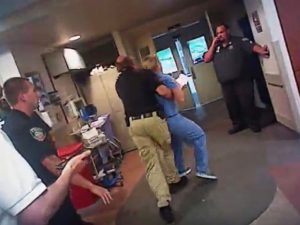
SALT LAKE CITY, UTAH – (ECWd) –
As an update to my previous analysis of the horrific (and likely unconstitutional) behavior of Salt Lake City police officer Jeff Payne and his July 2017 body-cam-recorded physical assault on University of Utah Burn Unit nurse Alex Wubbels, Salt Lake City Police Chief Mike Brown officially terminated Payne’s employment with the Police Department on October 10th, 2017; additionally, Brown demoted Payne’s supervising lieutenant, James Tracy, back down to the rank of “officer” (for his own poor judgment and his participation in Payne’s abuse of Wubbels). The perceived delay in terminating Payne and demoting Tracy was apparently due to the multiple (and lengthy) disciplinary steps required in Salt Lake City’s union contract, which establishes a rigid procedure for investigating allegations against police officers and giving them an opportunity to try to explain their conduct before Police Chief Brown is allowed to make any negative employment decisions against the officers.
The letters that Chief Brown wrote respectively to Payne and Tracy informing them of his decisions in their cases are worth reading in their entirety.
In my opinion, this is all a striking example of how important body-cam-footage is to protecting the public’s constitutional rights and how vital the Freedom of Information Act is in ensuring that the police can never destroy footage of themselves abusing or assaulting the public. If not for the body-cam footage that Alex Wubbels and her attorney obtained via FOIA request, it’s doubtful that Payne or Tracy (or other craven and still-unnamed officers who stood by and allowed Payne to assault Wubbels under color of badge) would ever have been held accountable. The body-cam video prevented these out-of-control policemen from lying about what they did to Wubbels and creating a “She said/Cops said” situation that Chief Brown could have ignored.
In our modern world where government employees sadly cannot be counted on to tell the truth (when the truth hurts them), if something is not caught on video then it didn’t happen. Whenever a member of the public is dealing with a police officer or other government employee who is abusing a person’s civil rights or mistreating that person in any way, a camera of some kind needs to be rolling to ensure that the government does not have any ability to lie about what those employees did to that private citizen.
Interestingly, large sections of Chief Brown’s termination/demotion letters are heavily redacted in greyed-out “Garrity protected” swaths. “Garrity protected” appears to be an unique exemption to FOIA production involving government employees being questioned in disciplinary investigations; the term apparently stems from the court case Garrity v. New Jersey (1967) that involved compelled statements made by public employees being inadmissible in subsequent criminal proceedings (due to the Fifth Amendment protecting an individual from being compelled to incriminate himself). The “Garrity protected” sections of Chief Brown’s letters to both Payne and Tracy appear to be where statements that Payne and Tracy made to investigators are quoted.
Though it’s impossible to even attempt to guess what’s hidden under the “Garrity protected” redactions, contextually it appears that these grey blocks appear where Payne and Tracy attempted to either justify their (unjustifiable) actions against Wubbels or deny aspects of what body-cam footage clearly recorded Payne doing to Wubbels.
Another important takeaway from Chief Brown’s letters is how often he references the immense damage to public trust that Payne’s assault on Wubbels inflicted. An informed and aware public that recoiled in coast-to-coast horror at what the Salt Lake City police did to that poor nurse (who was just standing up for the constitutional rights of her patient) and demanded action be taken against Payne and Tracy ensured that no cover-up or mere slap-on-the-wrist could be had in this matter. As a corollary to that “if it’s not caught on video, then it didn’t happen” rule, if a video of a public employee behaving horrifically goes viral then the government loses all ability to circle the wagons and side with its employee against the public (and the United States Constitution).
The Salt Lake City Police and the Mayor’s office seemingly did absolutely nothing about this matter for more than a month after Alex Wubbels was assaulted…until Wubbels’ lawyer released the body-cam footage and it went viral. Catching public employees behaving egregiously and then posting that video to the Internet for everyone to see appears to be one of the only ways that local government can effectively be pressured to do the right thing when public employees are decidedly in the wrong. If there is no video evidence, then it seems more often than not that public bodies circle their wagons and try their best to avoid accountability.
.








6 Comments
Sgt. Jack Webb - (LAPD Ret.)
Posted at 11:07h, 15 OctoberKevin is correct. Saw several documented cases disciplined for failure to activate audio and a couple for (prior to auto activation with emergency lights) failure to activate video. Video was usually in conjunction with failure to terminate an “attempt to stop” when speeds increased and violator was fleeing. Didn’t have any where the officer displayed malice toward the violator. These were all minor internal policy violations officers attempted to hide from their supervisors. Any way…
kevindujan001
Posted at 21:05h, 15 OctoberThis is anecdotal, but I believe it is true as it jives with the zeitgeist in the country right now. I’ve been told by friends in the legal profession that juries, at least in Chicago, are no longer believing the police when they come to testify. The police are now seen as liars by a growing majority of the public, due to the fact that the supposedly “good cops” that allegedly exist never seem to do anything to stop the bad cops. In the Salt Lake City case, the “good cops” (who were not assaulting the nurse) just stood there and let the assault happen. The public perceives police officers as sticking together and circling wagons to protect each other, no matter what they do…and that includes lying. 20 years ago, if a cop said something on the witness stand, a jury would believe it even without video proving the cop was telling the truth. Today, a jury is more likely than not going to think a police officer is lying unless there is video supporting what he is saying. This is because for so many years now the bad cops who lie and do things to hurt the public have had the police union protecting them and all other cops circle the wagons and protect the bad actors. Judges might still believe the police, but the regular people on juries no longer default to “believe the cop” unless there is proof the cop is not lying.
A. Lincoln
Posted at 06:40h, 13 OctoberAnother troubling incident is the delay in action by the chief of police. It appears now that the only thing which prompted the chief’s action was the public airing of the video. This speaks volumes about the chief. And the volumes are not good.
Police videos promote ‘equal justice under law’ in another way. Notwithstanding their protestations to the contrary, many judges listen to police officers, in the witness box and under oath, and rule as though the police officer is telling the truth. When everyone listening knows and can tell they are not. A video, even if not perfect or as clear as you would like, may show enough reasonable doubt to exonerate a defendant in a civil or criminal proceeding. And this works to everyone’s benefit. Even to honest police officers who may find themselves defendants.
Excellent analysis, Kevin.
Kevin duJan
Posted at 09:50h, 13 OctoberThe assault happened on something like July 26, when Officer Payne clearly violated Wubbels’ constitutional rights. To me it looks like the police chief, mayor, and everyone behaved just like they do in Illinois: they did nothing, circled the wagons, hoped it would go away, hoped no one would find out what the cop did to this nurse, etc. And then at the end of September, the video comes out. Then the mayor and the chief claim they only saw the video then. Why didn’t they watch this video right after it happened? Why was it not reported to them the day that the assault happened? A cop barges into a hospital to arrest a nurse and violates the Constitution…and the chief doesn’t have any interest in watching the video of that? The mayor has no interest in watching the video of what the cop did? Or, was it that no one told them? If so, just fathom the multiple layers of corruption and problems in both the police department and the mayor’s office if something this outrageous happens and the mayor/chief either aren’t informed or they are told but don’t care enough about what happened to watch the video. Then, when the video comes out, they act like Sergeant Schultz on Hogan’s Heroes: “They knew nothing, nothing, nothing…they saw nothing, nothing, nothing…they are shocked, shocked, shocked.” Yah, right.
McGarret - Five-O (The Original !)
Posted at 21:52h, 12 OctoberWhat some officers – and the public – don’t realize is, video often exonerates officers from false or exaggerated misconduct claims from the cop haters and those who just can’t perceive the facts – or accept them. Video is good for everyone.
Kevin duJan
Posted at 08:20h, 13 OctoberBody-cams are great for everyone. The big problem right now is that police in Illinois seem to have the ability to choose when to turn the cameras on and they can also tamper with their microphones so that they can turn off the audio when they don’t want to be heard. There must be a way to prevent the police officers from being able to turn off the audio and to turn off the video because when they are doing something wrong they obviously do not want to be recorded. If they choose to tamper with their cameras and microphones and thus footage does not exist, the presumption entering into disciplinary action should be that they did whatever they are being accused of doing, since they elected to tamper with the body-cams.